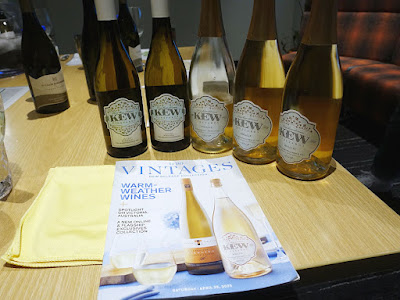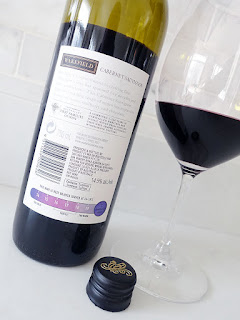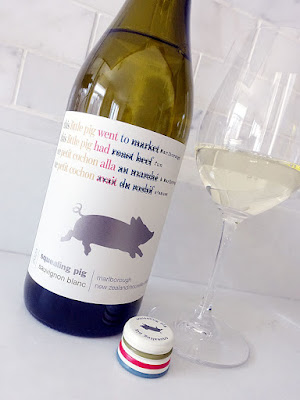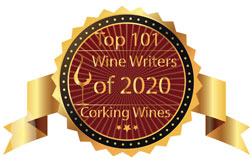white wine review is a refreshingly delicious Sauvignon Blanc from Margaret River. It made its debut at the LCBO earlier this month in the LCBO VINTAGES New Release Collection.
Like the 2018 Evans & Tate Hullabaloo Cabernet Sauvignon I enjoyed earlier this year, this white wine is produced by Evans & Tate, a winery whose roots were established in 1971 by two friends - John Evans & John Tate. In 1974, the friends and business partners purchased land and planted a vineyard in Wilyabrup, the heart of Margaret River, Western Australia, and named the vineyard Redbrook. Evans & Tate played pioneering roles in establishing Margaret River as a world-class wine region.
In 2012, Evans & Tate joined the Fogarty Wine Group portfolio of wine brands. The winemaking philosophy at Evans & Tate begins with accessing high-quality fruit and oak, as well as using state-of-the-art winemaking equipment. Senior Winemaker Matt Byrne, who has been at the helm of winemaking at Evans & Tate since 2001, continues to lead the team at Fogarty as they continuously strive to craft elegant wines which exhibit distinct regional characteristics and intense purity of fruit.
The Margaret River wine region is situated adjacent to the Indian Ocean and boasts optimal conditions for viticulture due to its proximity to the ocean, soil consistency, and generally perfect seasonal temperatures. Situated at an elevation of 295 feet above sea level, the Margaret River wine region features a high mean January (peak summer) temperature of 20.2°C, and a low mean annual temperature of 7.6°C, which translates to a pleasant year-around Mediterranean climate that is warm and dry during summer with cooling afternoon breezes, and a mild winter. The soil in the area is loamy sand and gravel, which was formed directly from underlying granite and gneissic rock.
Evans & Tate has been crafting Margaret River wines for over 50 years. Today, they have eight lines of wines ranging from fun-and-friendly to award-winning and sophisticated. This particular white wine is from their mid-range Wild Cape line. The Wild Cape range of three wines is a celebration of the raw beauty of Western Australia's southwest region and is inspired by the spectacular coastline and distinct regional characteristics of Margaret River wine. Adorning each label of Wild Cape wine is a dramatic photo by Andrew Semark that embodies the essence of the region where dramatic waves crash into the cape and world-class wines are produced in this remote, pristine part of the world. The photo that represents the Wild Cape Sauvignon Blanc is called ‘Void’ and captures the wave succinctly as "force, rare and relentless", terms which can also describe Margaret River Sauvignon Blanc as it offers a relentless wave of flavour with purity and energy, while showcasing the unique varietal characteristics of the region.
Crafted with 100% Sauvignon Blanc, the grapes for this white wine were picked at various times from small parcels in two vineyards in order to capture the myriad of aromas and flavours that Sauvignon Blanc vines produce at various ripeness levels. The grapes from the Karridale Vineyard were pressed upon arriving at the winery to soften acidity and to impart aromatic and textural complexity. The grapes from the Wilyabrup Vineyard were allowed to cold-soak on the skins for 24 hours before pressing and fermenting the clear juice. A small portion (13%) was allowed to undergo wild fermentation in used 500 L French oak puncheons to impart texture.
The growing season of the 2022 vintage began with a very wet winter, which led to good and healthy vine growth. The dry summer featured intense heat, which resulted in decreased yields. However, the dry, sunny days also provided a natural barrier to disease, while the extensive marri blossom kept bird pressure at bay. While some bunches suffered from sunburn, there were minimal challenges in the vineyard. Yields were lower than average, but the quality was the fruit resulted in outstanding wines. From a cracker of a vintage, let's see how this 2022 Sauvignon Blanc from Margaret River is tasting tonight...
Screw cap. Fresh and fragrant, the medium-high to highly aromatic nose delivers tropical fruit (passion fruit, guava), lime/lemon zest, citrus, and green herbal aromas with underlying savoury mineral and a touch of white floral. The medium+ weighted palate is dry and ripe with lime/lemon zest, passion fruit, guava, and herbs joined by mild spice notes. It has fresh and vibrant acidity, alongside a textured mouthfeel with good structure on the mid-palate. Lime zest, herbs, spice, and touches of mineral linger on the long, crisp finish. Chill well and enjoy this recommended buy on a hot summer day! Score: 89 pts
Other delicious wines by Evans & Tate are available at the LCBO, while the full range can be ordered through their Agent - Eurovintage Wines & Spirits.
Like the 2018 Evans & Tate Hullabaloo Cabernet Sauvignon I enjoyed earlier this year, this white wine is produced by Evans & Tate, a winery whose roots were established in 1971 by two friends - John Evans & John Tate. In 1974, the friends and business partners purchased land and planted a vineyard in Wilyabrup, the heart of Margaret River, Western Australia, and named the vineyard Redbrook. Evans & Tate played pioneering roles in establishing Margaret River as a world-class wine region.
In 2012, Evans & Tate joined the Fogarty Wine Group portfolio of wine brands. The winemaking philosophy at Evans & Tate begins with accessing high-quality fruit and oak, as well as using state-of-the-art winemaking equipment. Senior Winemaker Matt Byrne, who has been at the helm of winemaking at Evans & Tate since 2001, continues to lead the team at Fogarty as they continuously strive to craft elegant wines which exhibit distinct regional characteristics and intense purity of fruit.
The Margaret River wine region is situated adjacent to the Indian Ocean and boasts optimal conditions for viticulture due to its proximity to the ocean, soil consistency, and generally perfect seasonal temperatures. Situated at an elevation of 295 feet above sea level, the Margaret River wine region features a high mean January (peak summer) temperature of 20.2°C, and a low mean annual temperature of 7.6°C, which translates to a pleasant year-around Mediterranean climate that is warm and dry during summer with cooling afternoon breezes, and a mild winter. The soil in the area is loamy sand and gravel, which was formed directly from underlying granite and gneissic rock.
Evans & Tate has been crafting Margaret River wines for over 50 years. Today, they have eight lines of wines ranging from fun-and-friendly to award-winning and sophisticated. This particular white wine is from their mid-range Wild Cape line. The Wild Cape range of three wines is a celebration of the raw beauty of Western Australia's southwest region and is inspired by the spectacular coastline and distinct regional characteristics of Margaret River wine. Adorning each label of Wild Cape wine is a dramatic photo by Andrew Semark that embodies the essence of the region where dramatic waves crash into the cape and world-class wines are produced in this remote, pristine part of the world. The photo that represents the Wild Cape Sauvignon Blanc is called ‘Void’ and captures the wave succinctly as "force, rare and relentless", terms which can also describe Margaret River Sauvignon Blanc as it offers a relentless wave of flavour with purity and energy, while showcasing the unique varietal characteristics of the region.
Crafted with 100% Sauvignon Blanc, the grapes for this white wine were picked at various times from small parcels in two vineyards in order to capture the myriad of aromas and flavours that Sauvignon Blanc vines produce at various ripeness levels. The grapes from the Karridale Vineyard were pressed upon arriving at the winery to soften acidity and to impart aromatic and textural complexity. The grapes from the Wilyabrup Vineyard were allowed to cold-soak on the skins for 24 hours before pressing and fermenting the clear juice. A small portion (13%) was allowed to undergo wild fermentation in used 500 L French oak puncheons to impart texture.
The growing season of the 2022 vintage began with a very wet winter, which led to good and healthy vine growth. The dry summer featured intense heat, which resulted in decreased yields. However, the dry, sunny days also provided a natural barrier to disease, while the extensive marri blossom kept bird pressure at bay. While some bunches suffered from sunburn, there were minimal challenges in the vineyard. Yields were lower than average, but the quality was the fruit resulted in outstanding wines. From a cracker of a vintage, let's see how this 2022 Sauvignon Blanc from Margaret River is tasting tonight...
Tasting Note:
EVANS & TATE WILD CAPE SAUVIGNON BLANC 2022 - Margaret River, Western Australia (#41435) (XD) - $19.95Screw cap. Fresh and fragrant, the medium-high to highly aromatic nose delivers tropical fruit (passion fruit, guava), lime/lemon zest, citrus, and green herbal aromas with underlying savoury mineral and a touch of white floral. The medium+ weighted palate is dry and ripe with lime/lemon zest, passion fruit, guava, and herbs joined by mild spice notes. It has fresh and vibrant acidity, alongside a textured mouthfeel with good structure on the mid-palate. Lime zest, herbs, spice, and touches of mineral linger on the long, crisp finish. Chill well and enjoy this recommended buy on a hot summer day! Score: 89 pts
Other delicious wines by Evans & Tate are available at the LCBO, while the full range can be ordered through their Agent - Eurovintage Wines & Spirits.











































